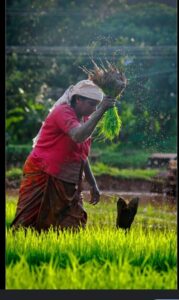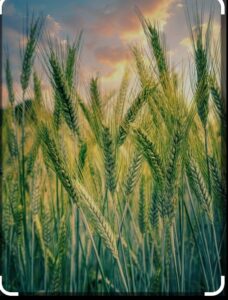Agriculture in India
Agriculture in India is the chapter of class 10 covering geography group with complete syllabus of the class for class 10

There are different of faming in the Agriculture in India
a) Primitive subsistence farming in this kind of farming the farmers have small land holdings, farming is done with old methods and tools like hoe, deo, digging stick, the farmers have to depend on monsoon and natural conditions and soil fertility. It is slash and burn farming.
b) Intensive subsistence farming this kind of farming is conducted in the aera of high population pressure land though it is labour intensive, high doses of biochemicals, irrigation is used for large production, but land holding size is not economical.
c)Commerical farming that is conducted use high doses of modern inputs such as fertilizers, pesticides, HYV seeds. It is mostly done in plantation such as tea, sugarcane,
CROPS AND SEASONS of Agriculture in India
There are three cropping seasons in India.
A) Rabi in this crop are sown in the month of October to December whereas harvesting in made in April to June major crops sown are wheat, , mustard peas barely.
B) Kharif in these seeds are sown in the month of May to July, harvesting is done in between September to October the major crops are paddy, Tur maize sugarcane.
C)Zaid in this crop are sown in between April to June major crops are watermelon, muskmelon, cucumber.
MAJOR CROPS of Agriculture in India:
There are three kinds of crops
a) food crops such as wheat, rice, pluses, maize, oilseeds etc.
b) cash crops which is sold in market such, rubber, coffee, jute, cotton. c)Horticulture crops which include fruits, flowers, vegetables.
PROCESS OF FARMING consists of following steps
1) Ploughing
2) Sowing
3) Irrigation
4) Weeding
5) Manuring
6) Spraying of insecticides
7) Harvesting
8) Threshing
9) Grain
IMPORTANT POINTS of Agriculture in India
1 Rice is the Commerical crop in Haryana and in Punjab but subsistence crops in Odisha. India is the second largest producer after China, and it is staple food for most of the people in our country.
2. Plantation farming a single crop is grown on the large aera. such as tea, coffee, rubber, banana.
3.Aus ,Aman ,Boro are the three crops of paddy grown in Assam, West Bengal, and Odisha. Wheat is the second important cereal of northern part of India.
4.Maize is the crop, which is used both as food as well as fodder, Jowar, bajra ragi coarse grain with high nutritional value are the millets grown.
5.India is the largest producer of pulses, second producer of sugarcane ground nuts after Brazil, and China respectively In case of rapeseed 3rd largest producer after Canada and China. In case of tea fruits and vegetables 2nd largest producers after China.
6.Crop Rotation It is the growing of different crops on a piece of land to increase the productivity and fertility of land.
7.Slash and Burn farming is also called shifting cropping in which farmer clear the patch of land and produce the cereals and other food crops for the sustainment of family. When the fertility of land decrease than he shift to other new patch of land for cultivation.
Different Names Given to Slash and Burn farming.
In Madhya Pradesh it is Bewar/ Dahiya, Andhra Pradesh it is Podu/Penda, Odisha it is Pame Daiber/Koman or Bringa, in West Ghats is Kumari, in the Southeastern Rajasthan it is Valre /Waltre , in Himalayan Belt is is given the name of Khil, Jharkhand is Kuruwa ,
Northeastern region is Jhumming .White Revolution is also called Operation Flood in which the breed of animals are improved with the help of new technology to increase the productivity of milk.
Green Revolution is to increase the agriculture production of wheat by use of modern technology, HYV seeds fertilizers etc.
MAJOR CROPS TERMS AND CONDITIONS of Agriculture in India
1 Rice sown in the month of June to July is kharif crop harvested in September to October needs max temperature of 25 deg and above rain fall is more than 100 cm mostly produced in west Bengal, U.P., Punjab.
2.Wheat is rabi crop sown in November to December, harvested in April to May, needs temperature of 21- 24 deg c with rain fall of 50 -75 cm mostly produced in East Punjab, Haryana, U.P., Bihar.

3.Mazie is the kharif crop which is sown in between June to July harvested in September to October need the temperature of 21 – 27 deg c required rainfall to 50 – 100 cm mostly produced in Karnataka, U.P., Bihar.
4.Sugar Cane is kharif crop which is sown in between January to March, harvested in the month of December to March temperature required in 21-27 deg C needed 75-100 cm rainfall mostly grown in Maharashtra, Karnataka, Tamil Nadu.
5.Tea is sown in between April to June/ October to December harvested after every 7-12 days temperature required 21-29 deg C rain fall required 150 to 200 cm mostly produced in Assam and West Bengal.
6.Cotton is sown and harvested at different period in different parts of the country for which the temperature required 21 to 30 deg C rainfall required 50 to 120, Gujarat, Madhya Pradesh, Karnataka.
7. Jute is called the golden fiber sown in the month of February on lowlands and uplands during March to May harvested in July to October the temperature required above 25 deg C the rainfall 160 to 200 cm mostly produced in West Bengal, and Bihar.
Conclusion: Agriculture in India
Agriculture in India is the main source of major employment and feeding source of
India . It is the 3rd largest producer of many crops in the world including wheat, rice, pulses, cotton, peanuts, fruits and vegetables . By 2011 India had largest herds of buffalo and cattle and the largest producer of milk and has one of the largest developing industry of poultry.
Read More : Resources and Development
Follow us on : Facebook